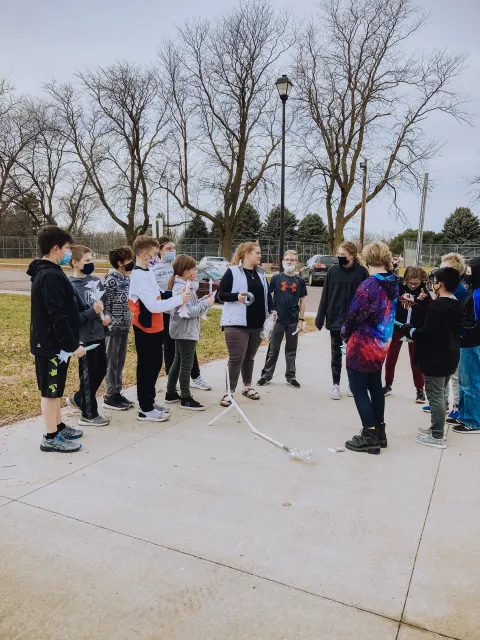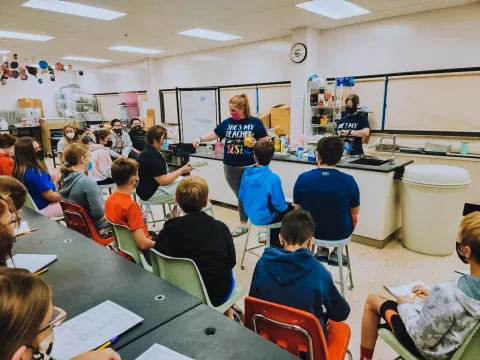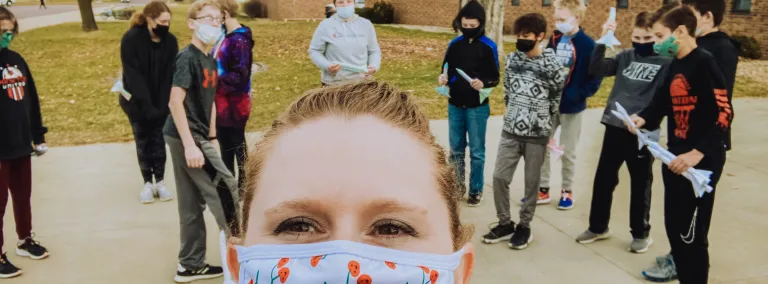Volcanoes, rivers and particles—bringing phenomena into the classroom
Nicole Mehlhaff uses meaningful phenomena from the natural world to engage her students at Yankton Middle School
Nicole Mehlhaff grew up in the shadow of three volcanoes: Mount Rainier, Mount St. Helens and Mount Adams, all just over an hour’s drive from her hometown of Naches, Washington.
With a degree in Earth science and a fascination for natural landscapes, Mehlhaff readily describes her home in geologic terms: “We lived in the subduction zone of the Cascade volcanoes,” Mehlhaff said. “The landscape was defined by lava plateaus and the ancient floods from the glacial Lake Missoula.”
In college, Mehlhaff studied the natural forces and geologic mechanisms that gave rise to the imposing Cascade Range and its towering volcanoes. She also studied education, learning to convey these Earth-molding concepts to young and curious minds.
Mehlhaff started her teaching career in Oregon and, during the summers, headed back to the mountains to work as a Teacher Ranger Teacher at Mt. Rainier National Park. There, she wrote curriculum, translating the beauty of the park into classroom lessons about tectonic plates, plant life and cloud formations.
When Mehlhaff moved to the Midwest in 2010, she found herself with few mountains to climb—but with plenty of geology to explore. “Where I live in Yankton, South Dakota, we are on the edge of ancient glacial sheets,” Mehlhaff said. “When the ice ages ended and the ice melted, it left behind the end moraines [debris deposits] we see today.”
Mehlhaff taught in the classroom during the school year then spent another summer with the national parks, this time at Missouri National Recreational River.
“The Missouri River follows the edge of the last glacial flow out of this area,” Mehlhaff said. “Where I live, just a few hundred yards from my backyard, is Gavin’s Point Dam—the last pinch point of the river. In the Missouri National Recreational River area, it’s free flowing and natural.”
Mehlhaff used her own experiences of volcanoes and river systems to bring Earth science topics to life in her classrooms—first in Oregon, then in Nebraska and South Dakota. She encouraged her students to look at the natural world around them and investigate which forces and mechanisms might have caused the features or phenomena they saw. Mehlhaff continued writing curriculum and even helped develop professional development programming for other educators.

Today, Mehlhaff teaches physical science at Yankton Middle School. Her sixth-grade students spend their schoolyear studying the structure of an atom, the forces that push and pull within our Universe, and the electromagnetic spectrum. These concepts—far more abstract than erupting volcanoes and melting glaciers—can be difficult for students to grasp.
Finding phenomena a mile underground
To help her students connect with the material, Mehlhaff turned to research that was happening in her students’ home state of South Dakota. Specifically, she turned to Sanford Underground Research Facility (SURF) where scientists are studying fundamental particles like neutrinos and dark matter.
These invisible particles can be difficult for most people to conceptualize, let alone for scientists to detect and measure. But SURF’s team of education specialists developed a curriculum unit to bring the search for dark matter into the classroom. And Mehlhaff was one of the first educators to test it in the classroom.
Through the curriculum unit, her students were introduced to the baffling observations in deep space that first convinced researchers that dark matter exists.
Mehlhaff dug deeper into SURF science. It was at a SURF professional development program for educators she first heard the pedagogical term “phenomena-based learning.”
“In phenomena-based learning, we start with a phenomenon that causes students to question what’s going on—something as simple as salt dissolving in water—and the lesson grows out of student questions and inquiry,” explained Deb Wolf, director of Education and Public Outreach at SURF. “The phenomenon gives purpose to the lesson. It preemptively answers the age-old student question: ‘Why do we need to know this?’”
To Mehlhaff, the approach was all-too familiar.
“Once I learned about the concept of ‘phenomena-based learning,’ I thought—Oh! I do that all the time!” Mehlhaff said. “And with the SURF professional development, I’m learning to pick phenomena that are truly meaningful to my students and meaningful for the concept I’m teaching.”
Exploring all the sciences
Though she focuses on physical sciences in class, Mehlhaff helps students explore all the sciences as the school’s Science Olympiad coach. In the program, students choose a topic to study, then compete in rounds of tests or building challenges, first at a state level then nationally. Topics span genetics, earth science, chemistry, anatomy, physics, geology, mechanical engineering and technology.
Since the nationwide program began 38 years ago, Yankton Middle School has been involved. And each year, the Yankton Middle School team has emerged as state champions and moved on to compete at the national level.

“Science Olympiad encompasses all the sciences, and students get to pick what they are interested in,” Mehlhaff said. “They get to choose a topic and really focus on an area they are passionate about and run with it.”
Locating the phenomena wherever you are
Just as Mehlhaff had been motivated to study her surroundings, she encourages students to explore the phenomena around them—whether it be the Missouri River that flows nearby or the neutrinos that pass through them every second.
“My students know that I’ve climbed a glacier and hiked up a waterfall. Because of where I lived, I got to do these awesome things,” Mehlhaff said. “But they can do a lot of things in their area, too, and I want to inspire them to take advantage of the opportunities that are out there for them.”
